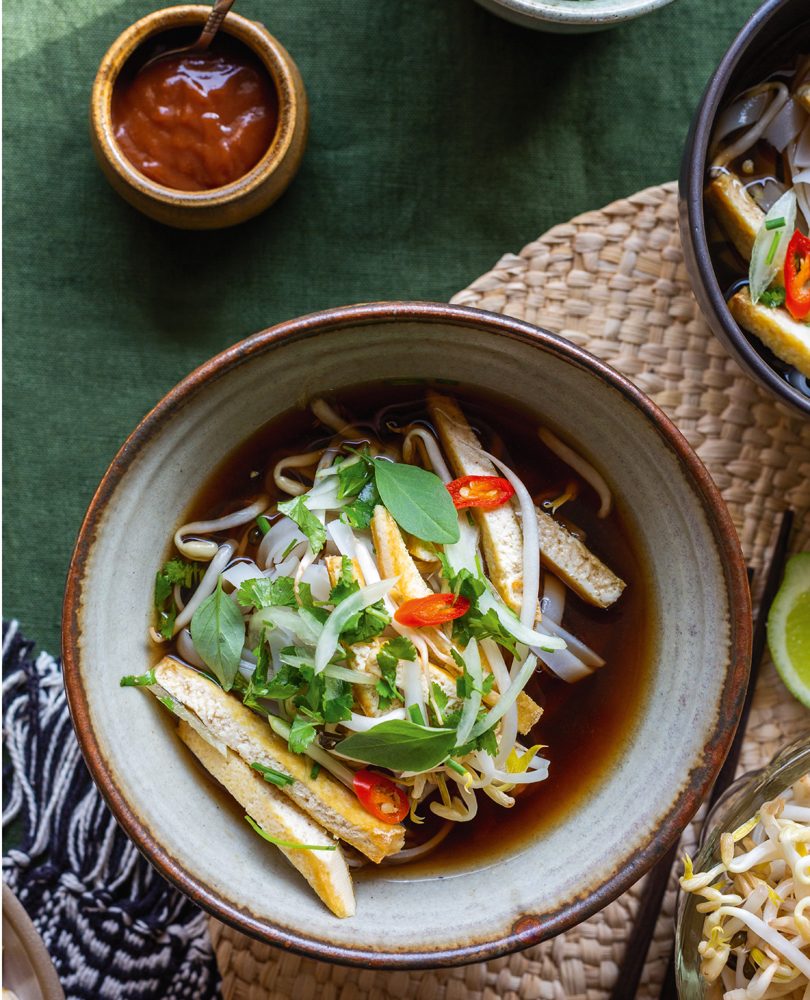VEGAN PHO
Emma Galloway

Serves
4Preparation
20 minsCook
1 hrIngredients
| FOR THE STOCK | |
| 20g (¼ cup) coriander seeds | |
| 6 cloves | |
| 1 cinnamon stick | |
| 2 star anise | |
| 2 slices dried licorice root (see NOTE) | |
| 1 teaspoon black peppercorns | |
| 1 teaspoon fennel seeds | |
| 1 long red chilli, halved lengthwise | |
| 1 onion, unpeeled, cut into wedges | |
| 5cm piece of ginger, unpeeled, sliced thickly | |
| 3 cloves garlic, unpeeled, bruised | |
| 2 carrots, ends trimmed, roughly chopped | |
| 2 celery stalks, roughly chopped | |
| 3 spring onions, ends trimmed, roughly chopped | |
| 125ml (½ cup) Shaoxing cooking wine or dry sherry (see NOTE) | |
| 2 tablespoons soy sauce, gluten-free if needed | |
| 2 tablespoons raw sugar | |
| 3-4 teaspoons fine salt, or to taste | |
| 185g (½ packet) dried flat rice noodles | |
| olive or coconut oil | |
| 1 x 300g packet firm tofu, cut into 1cm slices | |
| 1 onion, finely sliced | |
| big handful of coriander leaves and tender stems, roughly chopped | |
| small handful of chives, finely chopped | |
| 2 limes, cut into wedges, to serve | |
| sliced long red chilli, Thai basil & hoisin sauce (gluten-free if needed), to serve | |
| mung bean sprouts, to serve |
My husband was born in Vietnam not long after the war ended. His story is harrowing but sadly not unique, as many refugee families around the world have similar experiences of war and displacement. A few years after we met we travelled to Vietnam together, for the first time since his family fled when he was five years old. That trip was amazing in so many ways and healing for him, too, I imagine. As a food-obsessed traveler, I spent a lot of my time walking the streets, eating and observing how the locals live and eat, and the daily bowl of pho for breakfast is something, as a vegetarian, I wished I could join in with. There are pho shops everywhere in Vietnam, where people rub shoulders with each other as they sit upon tiny plastic chairs lining the footpaths, slurping up noodles and flavourful broth, adding herbs and lime juice as they do. My mother-in-law’s pho is legendary and when she makes it the whole family is invited over to share a bowl, or three. After many years of looking over her shoulder when she cooks, I came up with my own plant-based version and, while as a lifelong vegetarian I have no way of knowing if I’ve come close to the real thing, it’s something I crave often. This recipe is from my first cookbook My Darling Lemon Thyme (HarperCollins, 2014).
Instructions
| 1. | To make the stock, lightly toast all the spices in a dry frying pan for 1-2 minutes until fragrant. |
| 2. | Arrange the chilli, onion, ginger and garlic on a baking tray and char under a preheated grill for 6-8 minutes or until slightly blackened, turning occasionally to char all sides. |
| 3. | Place the spices, charred vegetables and the remaining stock ingredients, except the salt, into a large stockpot, add 2 litres (8 cups) of cold water and bring to the boil. |
| 4. | Reduce the heat to a gentle simmer and cook, uncovered, for 1 hour. |
| 5. | Strain through a fine sieve or piece of muslin, add salt to taste and set aside. |
| 6. | Meanwhile, soak the rice noodles in boiling water for 10-15 minutes or until pliable, then drain well. |
| 7. | Heat a little olive/coconut oil in a frying pan and fry the tofu slices for 3-4 minutes on either side, until golden. |
| 8. | Remove from the pan and slice into strips. |
| 9. | Mix together the sliced onion, coriander and chives in a bowl. |
| 10. | Arrange lime wedges, sliced chilli, Thai basil and hoisin on the table for everyone to serve themselves. |
| 11. | When ready to serve, bring the stock back to the boil. |
| 12. | Divide the noodles between four bowls, cover with boiling stock and scatter with a handful of tofu strips, some onion mixture and a handful of mung bean sprouts. |
| 13. | Encourage everyone to add as much lime juice, chilli, Thai basil and hoisin sauce as they’d like. |
| 14. | Any leftover broth can be frozen for up to 3 months. |
| 15. | NOTE You can find the ingredients for this recipe at your local Asian grocer. |
| 16. | Regular green cardamom can be used in place of black if necessary. |
| 17. | Licorice root is sold in small bags and looks like little dried pieces of wood chips, smells of licorice and gives a lovely sweet aniseed flavour to this soup. |
| 18. | Shaoxing (also known as shao hsing) is a Chinese cooking wine made from glutinous rice, yeast and water (and sometimes wheat). |
| 19. | It’s cheap and adds a lovely depth of flavour and can be splashed into stir-fries, too. |
| 20. | If you are coeliac or gluten sensitive and can’t find Shaoxing that doesn’t contain wheat, dry sherry can be used in its place, or simply use water. |
Recipes, food styling and photography Emma Galloway

Leave a Reply